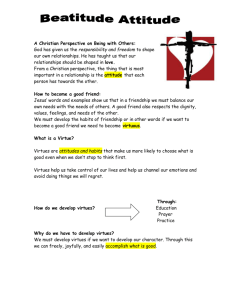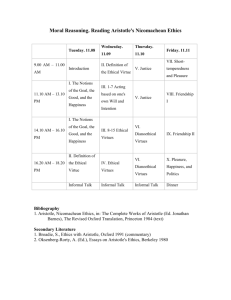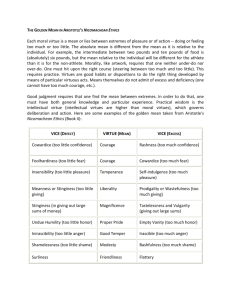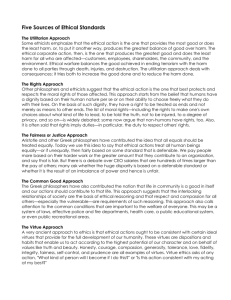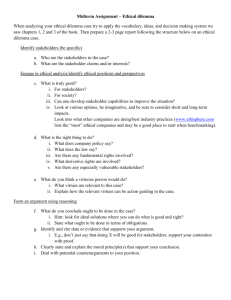Engineering Ethics Part 2
advertisement
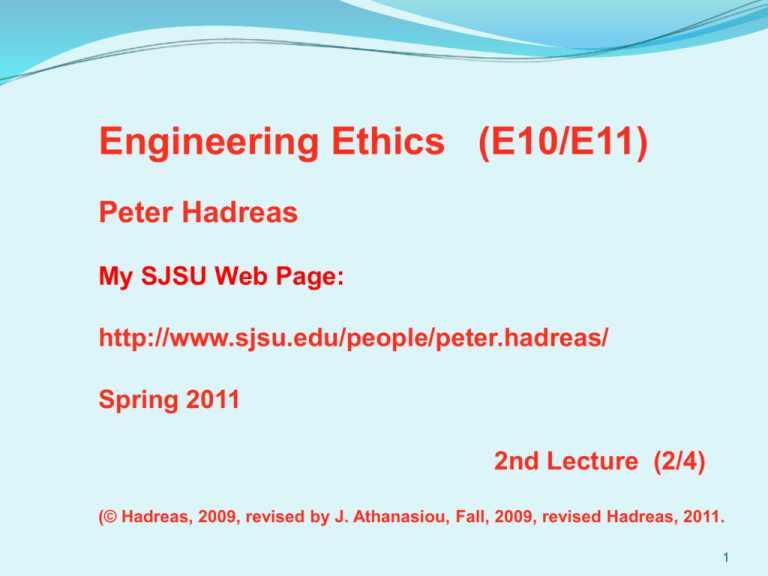
Engineering Ethics (E10/E11) Peter Hadreas My SJSU Web Page: http://www.sjsu.edu/people/peter.hadreas/ Spring 2011 2nd Lecture (2/4) (© Hadreas, 2009, revised by J. Athanasiou, Fall, 2009, revised Hadreas, 2011. 1 Review: Ethical issues come up very often for engineers. They often have serious consequences. They are resolved by practical reasoning. 2 Every ethical problem involves a relation of means to goals. 3 Ethical problems become particularly prominent when they involve a conflict of goals. 4 Basic goals (or virtues) that often come into conflict for engineers: A goal to maintain professional competence. A goal to be loyal to interests of employers and clients. A goal to be honest to employers, customers and the public. A goal to be non-discriminatory to co-workers and clients regarding their race, color, religion, gender, ethnicity, age or disability. A goal to use your skills and knowledge for the enhancement of human welfare and the environment. 5 So let’s consider a case. To pay for your education, you need to find summer work. You find a high-paying job as a forklift operator. It helps you to avoid taking out student loans. 6 You find yourself staring at a 50-gallon drum filled with used machine coolant, wondering what to do. 7 You know the coolant is toxic. Your supervisor, Max, at Natural Disposal, Inc., tells you to “Dump half of the coolant down the drain. Then dilute the rest with tap water and pour it out.” 8 “Dump half of the coolant down the drain. Then dilute the rest with tap water and pour it out.” 9 You tell, Max, “The coolant is toxic. It might cause heath problems to people who live around here, even birth defects and cancers.” Max says, “The toxic stuff sinks to the bottom of the drum. We’ve been doing this for years and nothing’s happened.” 10 You tell Max, “You mean no one said anything about it.” Max says, “You’re aren’t one of those environmentalists, are you? It’s time to get real and get on with the job!”1 Adapted from Harris, Pritchard, Rabins. (2005). Case #25, “Fork lifter.” In Engineering Ethics, Concepts and Cases. Belmont, CA: Wadsworth, p. 320. 11 All ethical problems involve a conflict in goals. In the Fork lifter Case you would experience a conflict between a. b. c. d. e. your loyalty to Max (your supervisor) as opposed to your professional competence. your loyalty to Max (your supervisor) as opposed to your duty to not pollute the environment. Max’s professional competence as opposed to Max’s honesty to a client. your professional competence as opposed to Max’s professional competence. your duty not to discriminate as opposed to your professional competence. 12 Conflicting Goals 5 4 Loyalty to Max Your professional competence. Loyalty to Max Your duty to not pollute the environment. Max’s professional competence Max’s honesty to a client. Your professional competence Max’s professional competence. Your duty not to discriminate Your professional competence. 13 Back to the Forklift Case. What do you do? Do what Max says? or 2 Walk off the job site? 3 14 You could say to yourself: “I’ll go along with this jerk for now. I’m out of here in a month anyway, then I’m back to SJSU.” 15 Or maybe you think to yourself: “Max is just the sort of $#^&*%$ who’s wrecking the environment. I’m out of here NOW. AND, I’m going to think about reporting Max to the Environmental Protection Agency.” 16 17 Definition of ‘Dilemma’: “a choice between two equally unfavorable or disagreeable alternatives”. OR 8 Not a pleasant choice 18 But as pointed out in the first lecture, although sometimes we are up against a wall facing a choice between two undesirable alternatives and must choose one of them, we usually can find a better solution. Finding the better solution requires we become skilled in ethical problem-solving. This skill consists in arriving at a third alternative that answers both sides of the dilemma and resolves the conflict. 19 In ethical problem solving, we consider paradigm cases that would ideally satisfy either side of the goals that bear upon the case. Next we analyze the features of the paradigm case. Then, by thinking analogically about the features of the paradigm case, we see if we can develop one that will answer both conflicting goals. Instead of A or B, find C that combines important features of A and B 20 So let’s apply it to the Forklift Case. What would a paradigm case of disposing of toxic coolants consist in? 1. The removal of toxic substances from the used coolant. The highest toxicities come from the heavy metals copper, lead and zinc. 2. A less toxic substance in engine coolant is ethylene glycol. It is treatable at wastewater treatment plants. So, the ‘heavy metal captured’ coolant must be disposed of in sewers that connect to wastewater treatment plants and never into surface or storm water collection systems. 21 You think more about the first feature of the paradigmatic disposal of coolants. The first feature: “The disposal of engine coolants requires the removal of the heavy metals copper, lead and zinc from the used coolant.” What if the removal of the copper, lead and zinc would result in recyclable coolant? 22 You look more in the recycling of engine coolant. You locate a firm, “Dawn Recycling Systems” Inc., that sells a coolant recycling system. The “Dawn Recycling System” captures the heavy metal contaminants, copper, zinc and lead, and leaves non-toxic the treated coolant. A “Dawn Recycling Systems” manager demonstrates that the system will pay for itself within six to nine months through the sale of recycled ‘tramp oils’, that is, through detoxified engine coolant. 23 So by considering the paradigm of safe coolant disposal, you’ve opened up a way to resolve the conflicting goals (and probably help your own career). Here’s a possible course of action: Inform Max that you’ve found a way to detoxify the 50 gallon drums and to also make money for Natural Disposal Inc. Ask him to accompany you to discuss the matter with his supervisor at the Natural Disposal Inc. main offices in Hayward , CA. There, you explain to Natural Disposal Inc. main management how Natural Disposal Inc. can avoid likely lawsuits coming from toxic dumping, make money on the recycled coolant in the long-run, and -- last but not least -- do the ecologically right thing. 24 Conflicting ethical goals, that appear to demand a choice between the ‘lesser of two evils,’ is called an ethical a. b. c. d. e. imperative. absurdity. entitlement. virtue. dilemma. 25 Confronted with conflicting ethical goals, that appear to demand a choice between the ‘lesser of two evils,’ ethical practical reasoning seeks to find a creative solution which a. b. c. d. e. Obeys the correct moral principle. Demonstrates the irrelevance of the ethical conflict. Appeals to the Will of a Higher Being. Satisfies both goals. Rules out the less morally significant goal 26 27 We have assumed that ethics is about finding creative solutions to conflicts between professional goals. But how can we decide and which goals are worth pursuing, whether professional or personal? 28 Deciding on the virtues of goals of life well-lived have long been a subject in Western philosophy. In the West, the goals of a good life were mapped out in detail by the philosopher Aristotle (384-322 BC). In the East, Confucius (551 - 479 BC) proposed a no less influential virtue ethics approach. 29 30 Consider Aristotle’s version of this approach 31 The proper middle way: Not enjoying sensuous desires enough: Insensitivity Deficiency. Knowing how to control your sensuous desires so you enjoy the desire, but not too much to harm your health. You arrive at the Virtue of Self-Control Enjoying sensuous desire too much: Wantonness Excess. 32 The proper middle way: Being not fearful enough: Recklessness Deficiency. Knowing how to control your fear so that it makes you more alert but does not overwhelm you. Knowing with whom to overcome fear and in what way: Being too fearful: Cowardice Excess. Virtue of Courage 33 Some Human Virtues According to Aristotle Issue Excess Middle=Virtue Deficiency Fear Cowardice COURAGE Rashness Pleasure of touch & taste Wantonness SELF RESTRAINT Insensibility Fame, Reputation Overly Ambitious SELF RESPECT Lacking in self respect 34 Further Human Virtues According to Aristotle Issue Excess Middle=Virtue Telling the truth about oneself Boastfulness TRUTHFULNESS Self-belittling Attitude toward the achievement Of others Social relations (in general) Envy ADMIRATION Selfsatisfaction FRIENDLINESS Sulkiness Obsequiousness Deficiency 35 How is confidence a valuable human trait? What are its excesses and deficiencies? 36 The answer is most important for a life well-lived. The active pursuit of these goals and an increased understanding of how to obtain them leads to happiness. 37 Just as the basic human virtues ensure a person’s happiness, …. the engineers’ professional goals or professional virtues ensure the success and flourishing of the engineering profession. 38 In the first case we looked at the fundamental principles in the Code of Ethics of the American Society of Civil Engineers. (ASCE) In fact this code condenses the professional virtues of civil engineering. 39 The Code declares: Engineers uphold and advance the integrity, honor and dignity of the engineering profession by: 1. using their knowledge and skill for the enhancement of human welfare and the environment; [social virtues] 2. being honest and impartial and serving with fidelity the public, their employers and clients; [self-directed virtues] 3. striving to increase the competence and prestige of the engineering profession; [proficiency virtues] and 4. supporting the professional and technical societies of their disciplines. [team-work virtues] 40 And notice how the professional virtues of the code of civil engineering is also subject to, excesses, deficiencies and finding the middle way. Take the virtue of being loyal to an employer. 41 The proper middle way: Being not loyal enough: Gross Insubordination Deficiency. Knowing that teamwork requires cooperation and leadership. Following the a fair employer’s leadership is a condition of successful group effort: Virtue of Employee Loyalty Being too loyal: Blind obedience Excess. 42 How does the professional virtue of loyalty to an employer apply to the Fork lifter case? What would be its excesses and deficiencies in this case? How might you be grossly insubordinate or too obedient? 43 What would be the value of being able to know the better means to the virtue of loyalty in the Fork lifter case? How would understanding this case and acting properly in a similar case help your career? 44 For next class: Read the case study, “The SJSU Apprentice” . Refer to class website for due date of HW 3&4 45

